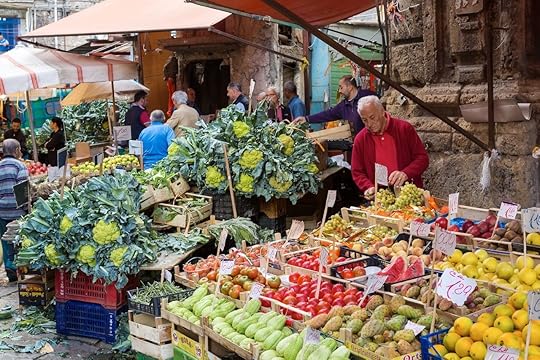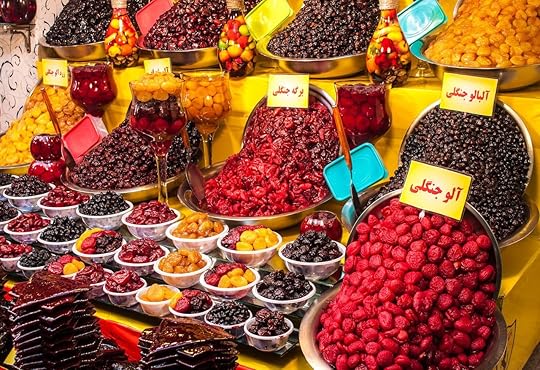Matador Network's Blog, page 1133
March 27, 2019
Keanu Reeves takes a road trip

When a United Airlines flight from San Francisco to Burbank was forced to redirect to Bakersfield, passengers ended up taking a van the rest of the way to LA. And they shared that van with none other than Keanu Reeves, star of John Wick, The Matrix, and Hardball, who happened to be on their flight.
One of the passengers, Amir Blum, posted a photo of himself and Reeves on Twitter with the caption, “That time when your flight out from [San Francisco’s Game Development Conference] almost crashes and you have to emergency land in a remote airport but at least Keanu Reeves is having as bad a day as you are.”
That time when your flight out from #GDC almost crashes and you have to emergency land in a remote airport but at least Keanu Reeves is having as bad a day as you are. pic.twitter.com/XSPa1wlNuO
— Amir Blum (Unboxed) (@CheesyJedi) 24 mars 2019
According to a spokesperson for SkyWest Airlines Corporate Communications, the flight diverted to Bakersfield due to a “mechanical indication” and “landed safely without incident.”
The emergency landing probably turned into one of these passengers’ more memorable trips. Reeves took a leading role in figuring out travel arrangements, and once aboard the van, even entertained riders by sharing fun facts about Bakersfield that he found on Google, and used YouTube to play local Bakersfield music. Passengers were quick to share videos of their experience with Reeves on social media.
THIS ENTIRE IG STORY ABOUT KEANU IS *italian chef’s kiss* PERFECTION ⭐️ pic.twitter.com/3rgPTkc3GV
— Ari Saperstein (@ari_saperstein) 24 mars 2019
While the flight diversion was undoubtedly a pain, it certainly sounds like Reeves, and the passengers, made the most of a bad situation. 
H/T: Entertainment Weekly

More like this: Experts weigh in: What to eat before, during, and after a flight
The post Keanu Reeves road trips with fellow passengers after emergency landing appeared first on Matador Network.

New Zealand visa for US citizens

Just like the US, Canada, and, more recently, the European countries of the Schengen Zone, New Zealand is introducing an Electronic Travel Authority, a new entry requirement for foreign nationals.
The citizens of the 60 countries belonging to the New Zealand visa-waiver scheme will be required to apply to obtain this authorization before traveling to the country. The new measure is meant to improve security and address smuggling and biosecurity concerns.
Travelers will now have to fill out an ETA form online by providing personal information such as their name, birthdate, passport details, etc., and pay a fee between six and eight American dollars. The ETA is valid for two years. Future visitors will also need to pay the country’s new International Visitor Conservation and Tourism Levy of about $24, which will go toward maintaining the infrastructure that supports visitors to New Zealand and helping conserve the natural environment.
Travelers from the 60 countries concerned will need to obtain the ETA before traveling to New Zealand starting October 1, 2019. 
H/T: Lonely Planet

More like this: The 7 most expensive tourist visas to save up for
The post In October 2019, US citizens will need a visa to visit New Zealand appeared first on Matador Network.

Best late-night bars in Chicago

When last call hits but you’re not ready to call it a night, Chicago’s so-called 4:00 AM bars have you covered. A standard tavern license in Chicago allows a bar to stay open until 2:00 AM (and until 3:00 AM on Saturdays going into Sunday), but a select number of bars with a late-night license can stay open until 4:00 AM (and 5:00 AM on Saturdays going into Sunday). These licenses are hard to get, making late-night bars few and far between.
Late-night bars are hubs for the not-ready-to-go-home drunk crowd. The scene is rarely pretty, but it is a great time. Whether you’re looking to dance, listen to live music, or just want to keep a great time going with friends, Chicago’s best bars for a late-night drink have you covered.
1. Smartbar
View this post on InstagramA post shared by smartbar (@smartbarchicago) on Feb 10, 2019 at 9:19pm PST
Smartbar is the city’s premier club for techno, and it attracts top DJs from around the world. After 2:00 AM, a stream of revelers from nearby bars join the party. Despite being located in the heart of Wrigleyville, Smartbar avoids the worst of the neighborhood’s bro culture, but not all of it. Anyone with dancing on their late-night itinerary should keep Smartbar in mind, but take note that there’s a cover charge.
Where: 3730 N Clark St, Chicago, IL 60613
2. The Green Mill
If you’re looking for a more upscale late-night experience, The Green Mill is where to be. This Uptown jazz club was a Prohibition-era speakeasy complete with subterranean tunnels to sneak booze in and people out. It had a reputation as a gangster hangout for people like Al Capone in the past, but today it’s more known for its live jazz, neon sign, Art Deco sculptures, and long bar.
Where: 4802 N Broadway, Chicago, IL 60640
3. Estelle’s
View this post on InstagramA post shared by Estelle's (@estelleschicago) on Dec 5, 2018 at 3:01pm PST
Located just steps away from the six-corners intersection in the heart of Wicker Park, Estelle’s has been in the 4:00 AM game for a long time. The Art Deco bar is nice, but the real attractions are the cheap drinks and inexplicably good burgers. It’s a small bar and gets crowded if you’re not in one of the booths in the back, but the atmosphere is nice and the jukebox plays the hits.
Where: 2013 W North Ave, Chicago, IL 60647
4. Old Town Ale House
The walls of Old Town Ale House are cluttered with framed drawings of the bar’s regular customers. That’s just one sign of the bar’s dedication to patrons that makes this a great place for a drink whether it’s early in the night or after all the other places have closed. Performers and spectators from the legendary Second City Comedy Club across the street are often here, making for a crowd that’s ready to laugh and have a good time.
Where: 219 W North Ave, Chicago, IL 60610
5. The Owl
View this post on InstagramA post shared by The Owl (@theowlchicago) on Feb 23, 2018 at 9:24am PST
This Logan Square dive bar has good tunes, people dance, the drinks are well-priced, and there’s always a good crowd. It’s no secret that The Owl is a fun bar, and there’s always a line late at night on the weekends. It’s worth the wait, and if you’re hungry there are good brats cooked up on the sidewalk nearby.
Where: 2521 N Milwaukee Ave, Chicago, IL 60647
6. The Continental
Along an industrial stretch of Chicago Avenue south of Humboldt Park and west of Ukranian Village, The Continental is a solid bar that draws in folks looking for a late-night drink from those two hoods. The bar has two floors and a back patio, and attracts people who work in the bar industry. Things you won’t experience here: top 40 hits and cocktails with over-the-top garnishes.
Where: 2801 W Chicago Ave, Chicago, IL 60622
7. Berlin
View this post on InstagramA post shared by Jordan Chavez (@inbetweenbranches) on Jan 15, 2019 at 12:54pm PST
Berlin is an LGBTQ bar, but anybody with a good attitude is welcome here. The music at Berlin is great and the crowd is always up for a good time. This is one of the city’s best spots for late-night dancing. There’s usually a $5-10 cover late at night, but the drinks are dirt cheap.
Where: 954 W Belmont Ave, Chicago, IL 60657
8. Ravens
Ravens is located smack in the middle of Lincoln Park, so there is a definite frat boy vibe here. Still, there are worse places around this neighborhood. Ravens is a solid dive where you can keep the party going and drink a few cheap beers. At the very least, you can get some free popcorn.
Where: 2326 N Clark St, Chicago, IL 60614
9. Clark Street Ale House
View this post on InstagramA post shared by Clark Street Ale House (@clarkstreetale) on Jan 27, 2018 at 9:41pm PST
Considering the typical bar-goer in River North, you’d expect a 4:00 AM spot in that neighborhood to be the biggest dive of them all. Somehow, probably due to all the bar and restaurant folks who come here to unwind, Clark Street Ale House is a damn good bar. Clark Street has had a huge craft beer selection since before it was cool, and its talented bartenders make excellent cocktails no matter how late at night.
Where: 742 N Clark St, Chicago, IL 60654 

More like this: 10 best places to drink wine in Chicago
The post 9 best bars for a late-night drink in Chicago appeared first on Matador Network.

March 26, 2019
Sake etiquette and traditions

If you’ve only ever tried sake at cheap sushi restaurants, you’d be forgiven for thinking that all sake is meant to be served hot and taken as a shot. But if you want to be taken seriously on your next trip to Japan, or even your local Japanese restaurant, you need to understand that sake is just as complex as any whiskey or wine. And more importantly, that the etiquette of drinking it in no way involves yelling “sake bomb!” and banging on the table until a shot of sake falls off of chopsticks and into a glass of beer.
If you want to drink sake (pronounced sah-kay, not sah-kee) as they do in Japan, you have to know the traditions that surround every aspect of this fermented rice beverage.
“Sake is said to have been a gift from the gods (Shintoism) being a very religious drink, which makes serving traditions very important,” says Jessica Joly, a sake sommelier and Miss Sake USA winner who works with New York City’s Tokyo Record Bar. “Still today it’s used for many serious ceremonies such as weddings, company openings, and funerals.”
There’s truly a sake for every occasion. There’s warm (okan), which is generally cheaper and sweeter; room temperature (joon), which is higher quality and sipped; and chilled (reishu), which is perfect for a hot day. Some occasions call for the fancier stuff while other times are served well enough with an affordable bottle.
“The broad nature of consumption is the main difference between how people drink sake in Japan,” Marc Smookler, the founder of the sake retail and education company Sake Social, says. “In the US, you are generally seeing people reserve sake consumption for sushi night, but in Japan; it’s not so precious. Drinkers are more knowledgeable about the many different styles of sake and therefore treat it more like a glass of wine in its ability to pair and be enjoyed with a wide variety of cuisines.”
First and foremost, respect pouring traditions

Photo: Rawpixel.com/Shutterstock
“Traditions play an important role in many aspects of Japanese culture, including sake, which has a history dating back to the eighth century,” Smookler says. “While there are many traditions involving sake surrounding celebrations (marriage, elections, changing seasons), the most elemental serving tradition is definitely that you should never serve yourself sake. Instead, your sake should be poured by a drinking companion, and you should return the favor throughout the meal.”
You’ll be given a ceramic sake cup called ochoko or choko when shaped like a small regular cup, or sakazuki when shaped like a flat saucer. Lift your cup and hold it with two hands, one around the sides and one supporting the bottom, while the host or person next to you pours the sake from a carafe (tokkuri). When it comes time for you to pour, make sure to pour with two hands as well.
Another type of glass you might come across is a masu, which is a small box that the ochoko goes inside. To show generosity, Smookler says, pour sake in the ochoko until it overflows and fills the box.
“The more formal the occasion, the more formal the etiquette,” Julia Boyd, founder of The Etiquette Consultant, says. “Japanese customs have some very important rituals all concerning the importance of giving and receiving, and it’s the same for giving and receiving sake .”
When you’re out with friends, two-handed customs can quickly fall off. It’s common, however, to keep the two-handed pour and receiving method when drinking with someone who is a higher class or status than you, like a boss, for example. Just make sure you start out on the formal side before switching to anything more casual. When in doubt, follow the lead of your host, so you don’t offend anyone or bring bad luck.
“If you are a female and you pour your own glass, they say you will never get married, and if you are a male they say that you will never advance in the work field,” Joly says. “This also makes it that much more of a communal drink to share and pour for others which creates interaction, called o-shaku.”
The communal drinking traditions have spawned words that relate solely to the drinking experience.
“It’s funny, because in Japan there is a word called nominication, which is a word they created,” Joly says. “Nomi means ‘to drink,’ and nication is the term taken from ‘communication.’”
How to drink sake

Photo: takasu/Shutterstock
“Generally speaking, in the US, once people see a little sake glass they seem to want to shoot it,” Joly says. “I don’t know if it’s because it looks like a shot glass, but many times instead of sipping sake they shoot sake, and of course there are still places that are offering sake bombs, which you would never see in Japan.”
Drinking only happens once everyone has a full glass. A short cheers (kanpai) is said, then glasses are either clinked or raised. Make sure the highest seniority person at the table has the highest raised glass if you’re in a more formal or business environment. When you’re done drinking, leave some sake in your cup, otherwise people will continue to top you off.
While there are a lot of different types, you’ll generally come across four different styles:
Junmai: Basic sake from lightly milled rice grains. Often the most affordable option and is sold warm, chilled, and sometimes at room temperature.
Honjozo: Sake that has a small amount of distilled alcohol added, which bumps up the percent a bit.
Ginjo: Made with rice that’s highly milled. Served at room temperature or slightly chilled.
Daiginjo: The highest quality, and therefore most expensive, type of sake that uses the highest level of milled rice grains. Served at room temperature or slightly chilled.
While some sake can be enjoyed warm, the majority of “hot sake” you find at sushi restaurants is probably their worst, cheapest sake warmed over to mask the flavor and should be avoided at all costs.
How to drink sake with food

Photo: Shinari/Shutterstock
“In Japan, food is an integral part of the drinking experience, and people are supremely attuned to flavors and how things pair, so choosing the right drink to accompany their meal is given a good deal of thought,” Smookler says. “Even the local pubs where they gather to drink after work (called izakayas) prepare food that is specifically meant to pair with alcohol (a far cry from the wings and nachos we call bar food).”
Lighter and floral sakes are served with lighter dishes like sashimi, while fried and heavier dishes call for something a little heftier.
“In Japan, sake is paired with food to help elevate its natural flavors,” Chris Johnson, a board member of The Joy of Sake, says. “It’s one of the few beverages that naturally contain umami — the fifth taste that is partly developed by the presence of glutamates (glutamic acid). Some examples are served warm along with a duck hot pot, room temperature with grilled vegetable, or chilled with light preparations of fish, chicken, pork, or beef.”
Luckily, there are enough sake styles to match whatever your needs.
“Sake is a traditional drink that is consumed throughout the whole meal,” Joly says. “Typically, junmai styles or futsushu (table sake) is enjoyed more on a regular basis in the household, but you see more of the premium styles of ginjo sake being served at many restaurants and izakayas. Recently, sake has seen a boom in blending and mixing with whisky, tea, and spices at Japanese bars with bite-sized snacks. Sake is enjoyed many different ways, and there are no limitations with food. Trust me, sake pairs really well with pizza!” 

More like this: If you love Japanese whisky, you have to visit these distilleries
The post You’re drinking sake wrong. Here’s how they do it in Japan. appeared first on Matador Network.

Vegan food tours around the world

Veganism isn’t just for incense-burning yogis anymore. Now, your bro who went a little too hard in Vegas comes back talking about, “I’m going vegan for a few weeks; I need to clean out,” like he’s pledging to take up running. Even the fried chicken joint on the corner has a little section of its menu dedicated to vegan options. So maybe it shouldn’t come as a complete surprise that there are entire vacation packages based around sampling vegan cuisine.
Thanks to Vegan Food Tours, the first company to run vegan walking tours in multiple cities, you can explore food capitals like London and Barcelona. For longer vacations, you can also eat your way through cheese-happy Italy or fish-infused Thailand without touching an animal product. Or even take a vegan safari. We scoured the globe for the best food tours for vegans and found 11 that’ll appeal to even the most die-hard carnivore.
1. Barcelona

Photo: Vegan Food Tours/Facebook
Catalan cuisine isn’t ALL shellfish and cured pork. There are olives too! Actually, Barcelona has a ton of spots for vegans, and a three-hour walking tour with Vegan Food Tours takes you through the best ones in Barca’s most popular neighborhoods. Start just off La Rambla and stroll through El Raval, El Barrio Gothic, and El Borne, marveling at the architecture while dining on plant-based tapas. You’ll find vegan takes on stuff like paella and patatas bravas, as well as vegetable dishes that outshine anything made with meat.
Cost: $72
2. Israel

Photo: Asya Nurullina/Shutterstock
When your national food is ground chickpeas deep-fried and served with a salad, it’s easy to become the most vegan-friendly nation in the world. Needless to say, touring Israel is easier for vegans than, say, Texas. Still, if you want a trip where you won’t have to ask a single restaurant how they make their pita, try Yarkon Tours’ eight-day Israel itinerary. You’ll kick off the week with a vegan feast in Tel Aviv, then move on to a vegan tour of Jaffa’s famous market. On the complete trip, you’ll learn about olive oil production, go wine tasting in the Golan Heights, and hit all the holy sites in Jerusalem with vegan dinners at Tmol Shalom and The Eucalyptus.
Cost: Daily three-hour tours for $50; full eight-day itineraries start at $1,810
3. India

Photo: Intrepid Travel/Facebook
Indian cuisine has long been a favorite of vegetarians thanks to its focus on sauces, spices, and vegetables in many of its staple dishes. India’s such a logical destination for vegans, Intrepid Travel’s initial vegan tours sold out in weeks this year, though thankfully they’ve added a slew of new departures.
The tour runs through Delhi, Agra, and Jaipur, where you’ll tour the cities’ less-traveled areas, tasting vegan street food you’d likely never discover otherwise. Then stay in the Castle Kanota in Rajasthan, where you’ll get a vegan feast and vegan cooking classes from locals. The whole thing is run by a team of vegan influencers from the UK, Canada, and Australia who worked with residents to come up with the ultimate itinerary.
Cost: From $980 for eight days
4. Italy

Photo: DeymosHR/Shutterstock
There’s no shortage of city-specific vegan tours in Italy. Vegan Food Tours runs a three-hour trip through Rome’s Monti neighborhood sampling vegan pizzas, antipasti, and pasta (most pasta is just flour and water, after all). Vegan Jaunts and Journeys will also be hosting a 10-day trip May 4-13 through Rome, Florence, Venice, and Bologna, though details won’t be available until April.
For the vegan who likes to plan things in advance, Intrepid has an eight-day Italian vegan food tour through Venice, Bologna, San Gimignano, and Rome, which includes two nights at an all-vegan Tuscan villa. You’ll also get to dine in Venice’s first all-vegan restaurant, La Tecia Vegana, and another one in Rome that’s been in business for 30 years.
Cost: Day tour starts around $75; Intrepid eight-day tour goes for around $2,329
5. Montreal

Photo: Ronnie Chua/Shutterstock
A city best known for its egg-heavy bagels and smoked meat sandwiches isn’t an obvious vegan paradise, but Mountreal’s Round Table Tours offers a bike tour of the city that delves into its sustainable eating practices. You’ll roll through Montreal’s green alleyways, passing urban farms, mushroom growing sites, and beekeepers. You’ll also visit two urban food production sites and gorge on an eight-course tasting menu at an organic vegan restaurant. Make sure to book this one during festival season, though, as it only runs from May to October.
Cost: $135
6. Paris

Photo: lembi/Shutterstock
Eating butter-free croissants and splurging on dairy-free cream sauces seems about as good a use of your Paris calories as having a Big Mac on the Champs D’elysee, but dig a little deeper and you’ll find French vegan food can be just as delicious as its dairy-fueled counterparts.
VegNews will prove it to you on its weeklong vegan tour of Paris, where you’ll take vegan French cooking classes, have a picnic at the Eiffel Tower, and generally do all the things non-vegans do when they visit. That includes wine and chocolate tastings, as well as high tea and pastry tours. You’ll also do a moonlight cruise along the Seine, get a private tour of Versailles, and bike through the city’s less-explored backstreets.
Cost: Starting at $4,395 per person for a double occupancy room
7. London

Photo: Vegan Food Tours/Facebook
Vegan Food Tours offers a couple of three-hour walking tours of London, hitting Shoreditch and Camden Town for the best plant-based foods in the UK. In Shoreditch, you’ll start at the Old Street tube station, walk past some of Banksy’s most notable works, and enjoy food and drinks from four restaurants in one of London’s best culinary neighborhoods. In Camden, you’ll explore London street food, trying stuff like vegan fried chicken and loaded nachos from stands along famous Camden Market. It’s a bit more chaotic than some other tours on this list, and probably the least healthy. But, if you’re on vacation, that’s kind of the point.
Cost: Camden $44, Shoreditch $67
8. California

Photo: Aaronj9/Shutterstock
It doesn’t get much more California than bicycling through the hills eating vegan food, does it? Vegan Epicure Travel thinks so, as shown by the company’s vegan eating version of the Amgen Tour of California that goes through the Central Coast, the San Joaquin Valley, and Lake Tahoe before finishing in Sacramento. Though you won’t be riding in the race itself, you’ll be taking the same path, mingling with pro cyclists while you enjoy vegan food from some of California’s best restaurants. And if you find yourself in an inescapable vegan food coma, there’s a support vehicle to drive you as long as you need.
Cost: $4,495
9. Iran

Photo: Matyas Rehak/Shutterstock
If you needed a sign that Iran was making waves as a 21st-century travel destination, look no further than its first and only vegan tour. These twice-annual trips take you through the fascinating history of Persia and Iran, from the artifacts of ancient capitals to fine art in centuries-old mosques. Over 12 days, you’ll sample vegan Persian food from restaurants, homes, and street vendors and learn how cuisine has helped shape the region’s history. The small-group tours provide a guided way to discover a country some might be a little hesitant to visit while learning about food from people you’d never otherwise meet.
Cost: $1,800
10. Thailand

Photo: Kuruneko/Shutterstock
For non-lovers of seafood, Thai cuisine can present a quandary: Nearly every sauce, curry, and noodle dish you order has shrimp paste or fish sauce in it somewhere, and oftentimes the special “vegan pad thai” at the bottom of the menu is your only option. A better option, however, is Intrepid’s eight-day journey from Bangkok to Chiang Mai where you’ll discover what Thai chefs are doing with ingredients like mushrooms, bamboo, and coconut cream. In Kanchanaburi, you’ll visit a local market with a chef to pick fresh vegetables for a meal you create that night. And you’ll visit Bangkok’s famous Chinatown where you’ll discover all sorts of plant-based dishes you hadn’t heard of.
Cost: $1,205
11. Vegan Safari in Botswana

Photo: Donovan van Staden/Shutterstock
Some might say there’s an inherent conflict in taking a vacation where you spend the day appreciating wild animals, then spend the night eating other ones. Vegan Safari Africa is about loving all animals, and in addition to taking you through some of the most pristine game reserves in Africa, they’ll feed you an all-plant-based diet while you’re there. The trip won’t be without its meat-eating, though, as many guests report witnessing lions stalk and devour a wildebeest, or seeing vultures descend on a fresh kill. But marveling at the food chain while voluntarily removing yourself from it can be a life-altering experience. Or at least a way to see how hard other animals have to work for their food.
Cost: Available upon request 

More like this: The 50 best US cities for vegans and vegetarians
The post 11 vegan food tours around the world that even meat-eaters will love appeared first on Matador Network.

Boeing 737 MAX emergency landing

The saga of the Boeing 737 MAX aircraft continued Tuesday when a plane operated by Southwest Airlines reported an engine problem en route from Florida to California. The plane landed safely, albeit about 2,500 miles from its intended destination of Victorville, California. Thankfully no passengers were on board this plane as it was being ferried by another aircraft to Southwest’s storage facility and not in service. The airline reportedly owns 34 Boeing 737 MAX aircraft and has moved 15 of them to its Victorville storage facility since the FAA grounded the aircraft following a fatal crash in Ethiopia on March 10.
Southwest Flight 8701 departed from Orlando International Airport around 2:50 PM. The plane’s crew declared the emergency shortly afterwards, after experiencing the engine issue during takeoff. The plane was redirected back to the airport and touched down without further incident.
The news comes at a sensitive time for Boeing and the commercial airline industry following the fatal crash of the aircraft in Ethiopia earlier this month, which killed 157 people, and another in Indonesia that killed 189 people in October 2018. The FAA is currently investigating the two fatal incidents to determine what, if any, similarities there are between them and what steps Boeing must take to ensure passenger safety on the aircraft.
According to a report in the Seattle Times, Southwest plans to store its 737 MAX aircraft at its Victorville facility until Boeing releases a software fix for the aircraft. Once approved by the FAA, the software will be installed on the planes at the storage site prior to them being declared safe for commercial use. 
H/T: Seattle Times

More like this: Boeing orders its entire 737 Max 8 fleet to be grounded
The post Boeing 737 MAX ferry flight makes emergency landing after engine problem appeared first on Matador Network.

New $33 London-Edinburgh train

Traveling between London and Edinburgh is about to get easier, and cheaper, than ever. A new rail link, slated to open in fall 2021, will bring passengers between the two major cities in just four hours for an average of 25 British pounds, or about $33. (Some fares may be even lower.) Right now, the average journey time between Edinburgh and London is five hours and 30 minutes, and tickets can cost up to $200.
The service will be operated by FirstGroup, which has ordered five new electric trains that run at 125 MPH and will be equipped with free WiFi and onboard catering. Inspired by the ultra-fast Japanese bullet trains, the London-Edinburgh trains have been purchased from Japanese firm Hitachi. And since the trains are electric, they will be quieter and more environmentally friendly than the current trains used for the journey.
Steve Montgomery, First Rail’s managing director, said in a statement, “There’s a real gap in the market for truly affordable rail travel between the two capitals — our plans show we are serious about competing with low-cost airlines and opening up rail travel on this key route to thousands of new passengers.”
Five trains are scheduled to run each day, from King’s Cross in London to Edinburgh station, passing through Stevenage, Newcastle, and Morpeth. 
H/T: Lonely Planet

More like this: The 11 most beautiful train stations around the world
The post New ultra-fast electric train will take you from London to Edinburgh in just four hours for only $33 appeared first on Matador Network.

The best things to do in Naples

Naples is usually thought of as a gateway to the beautiful Italian islands that lie a short sail away from its busy port. It’s rarely a destination in its own right. Many cruise tourists come home bemoaning the short time they spent in Naples before getting shuttled to the Amalfi Coast, knocking the city for its crowded streets, dilapidated buildings, and perceived danger — thanks to uptight, outdated guidebooks that would have you believe every person in Naples is out to rob you.
Despite the bad press, though, bustling and noisy Naples is a vibrant, culturally rich city that’s long overdue for an embrace from visitors. It’s the birthplace of pizza (that alone merits your respect), and it’s packed with internationally important archeological finds. It has a spirit of generosity and offers a view into Italian life not obscured by tour group flag poles. Of course, you should watch your valuables and avoid unknown areas after dark, but that’s true in a lot of big cities. Here’s why we love Naples — and why you will too.
It has diet-destroying street food.

Photo: Ivanchik/Shutterstock
Plenty of Italy’s most famous dishes were once the food of the poor, and Naples’ street food is no exception. From small shops and stalls around the center, you can order these calorific, often deep-fried snacks to go. Among the most prevalent are fried pizza, which can be tried at the historic La Figlia del Presidente, and the cuoppo, a paper cone filled with various deep-fried morsels like fish, mozzarella, or potato croquettes, which you can order to go from Fiorenzano. You can also find pizza a portafoglio, a folded slice to make street side eating convenient, or a frittatina di pasta, deep-fried pasta with mozzarella and tomatoes.
And waist-widening pastries.

Photo: AP_FOOTAGE/Shutterstock
Mornings in Naples are no less indulgent. You’ve got to celebrate a city that condones having a rum-soaked pastry with your morning cappuccino. Naples’ street-food stalls are complemented by pastry shops selling yet more calorie-rich food. (The “Mediterranean diet” is a myth.) Two pastries you should try are sfogliatelle, shell-shaped flaky pastry filled with ricotta and candied citrus peel, and babà al rum, which has a doughnut-like consistency and is soaked in plenty of rum. Try Pasticceria Capparelli in the historic center for a babà of generous proportions.
Charity is performed with coffee.

Photo: Yulia Grigoryeva/Shutterstock
The phenomenon of paying for two coffees so that the second can be given free of charge t in Italian and ‘o cafè suspiso in the Neapolitan dialect). This is a local custom you should definitely adopt — and then bring back to your home country.
Locals take to the streets.

Photo: edella/Shutterstock
Naples is known in general for its sense of community and communal living. You’ll see people sitting outside their front door on a kitchen chair watching life go by, laundry drying out on the street, and impromptu outdoor concerts in the evenings hosted in piazzas. All you need to do is walk around and adopt the attitude of the flanêur, or lounger, who, as poet Charles Baudelaire put it, finds “immense joy” in both observing and being part of his surroundings.
It’s a center for archeological study.

Photo: Vladimir Korostyshevskiy/Shutterstock
Not only does Naples offer easy transportation to crucial archeological sites Pompeii and Herculaneum, but inside the city itself, you can also see important archeological finds. The National Archeological Museum exhibits a vast collection of ancient Greek and Roman artifacts, many of which are from Pompeii and Herculaneum. One of the highlights is the celebrated Toro Farnese sculpture, a Roman copy of a Hellenistic sculpture which is the largest sculpture yet found dating from antiquity. There is also a secret chamber, the Gabinetto Segreto, with a collection of erotic art that was discovered in Pompeii and Herculaneum.
There’s beauty — if you know where to find it.

Photo: Mikhail Yuryev/Shutterstock
Naples is sometimes seen as a sprawling metropolis with trash-filled streets due to frequent strikes; disorderly traffic; and dark, narrow alleys. But there are also extremely beautiful pockets of the city. One self-professed “oasis of peace and tranquility” is the Santa Chiara monastery. The cloister is covered in sunny colored tiles decorated with flowers and leaves, and you might see a gardener unhurriedly tending to the lemon trees. Another way to escape the chaotic streets is to climb Via Petrarca in the Posillio area, where you will get a panoramic view of the bay of Naples with ethereal Mount Vesuvius beyond.
It’s home to artistic masterpieces.

Photo: Gimas/Shutterstock
The Veiled Christ in the Sansevero Chapel is one of the most arresting, and possibly most beautiful, representations of the dead Christ. The way the gossamer thin fabric drapes over the body makes it hard to believe it’s been sculpted from marble. Naples was also the home of the great Baroque master Caravaggio, once when he was facing a death sentence for murder. His dark, brooding scenes and dirty peasant representations of religious figures meant many of his works were considered shocking and blasphemous at the time. You can see his Seven Works of Mercy in the Pio Monte della Misericordia gallery, his Flagellation of Christ in the Capodimonte Museum, and his Martyrdom of Saint Ursula at Palazzo Zevallos.
Its pizza has UNESCO World Heritage status.

Photo: Vladimir Staykov/Shutterstock
Finally, Neapolitan pizza has been given the recognition it deserves. The art of pizza-making in Naples was designated by UNESCO as intangible cultural heritage in 2017. The work of the pizzaiolo, or pizza maker, involves four key stages of preparation, including the famous rotating of the dough. Beyond turning out really, really good grub, pizza-making in Naples is an art that brings together several generations, as young apprentices learn from their veteran masters. To choose where to eat a real Neapolitan pizza, look out for the Associazione Verace Pizza Napoletana (AVPN) signs above restaurant doors, meaning it boasts a certificate from this regulatory body, or opt for places with a long line. Pizzeria Sorbillo is considered by the AVPN as one of the best places to try traditional Neapolitan pizza, and it’s run by one of the oldest pizzaiolo families in Italy. 

More like this: Padua is the answer to an overcrowded Venice
The post Naples may be rough around the edges, but here’s why we love it anyway appeared first on Matador Network.

Apple releasing the new Apple Card

Apple plans to drop a major bomb on the credit card landscape. This summer, the tech company will release its first credit card, aptly titled the Apple Card, with the mantra is that this is a card “created by Apple, not a bank.” The card’s features (and shiny aesthetic) are certain to appeal to the modern spender. Applications for Apple’s premiere foray into lending you money opens this summer, but is it worth having it in your wallet if you’re a travel-credit-card enthusiast? Here’s everything you need to know to be prepared on release day.
The basics
In true Apple fashion, the Apple Card looks as though it will work seamlessly with other Apple products and horribly with everything else. Similar to Apple Pay, iPhone users will be able to store card details and manage their account in the Wallet app, and buy something in about as much time as it takes to make a fingerprint or scan your face. Balance and payment details are displayed right in the app, which also hosts a nice big payment reminder, so you won’t be hit with unexpected late fees.
In fact, there are no late fees, and according to Apple, there won’t be any fees at all. They’ve tossed the annual fee, cash advance fee, and over-the-limit fee out the window as well. They’ve even ditched the expiration date. According to the card’s website, “Our goal with Apple Card is to provide interest rates that are among the lowest in the industry,” though exact interest rates have yet to be disclosed, and you likely wouldn’t know yours until after the application process. The fine print reveals that in the case of missed payments, they’ll hit you with added interest instead of a fee, though, so you’re not totally off the hook.
Most ubiquities of modern credit cards are found on the Apple Card. For example, purchases are categorized, so you know how much went to productive purposes and how much you should rightfully cringe over. The balance statement promises to be straight forward about how much interest you’ll pay based on your desired payment amount, which won’t have any actual impact on your rate or what you’ll pay but is at least a step forward from most cards in terms of transparency.
Apple also addresses the issue of the forgetful spender. Each time you make a purchase, the business location will be stored on a map in your account so that before you get all up in a tizzy thinking your account was hacked, you can view the purchase details and remind yourself that it was, in fact, you that spend $500 on Amazon after a few too many glasses of wine last month.
Rewards program
No matter how much you spend with the Apple Card, there are no points or miles logged and no free portable Bluetooth speakers showing up at your door. Instead, the company offers rewards in the form of what it calls Daily Cash, a somewhat misleading moniker given that there is no actual cash involved. A percentage of each purchase will be loaded onto your Apple Cash card, which effectively works like a debit card, and you can then spend that toss back on whatever splurge suits your fancy. The exact “cashback” percentage is set to be between 2% and 3%, above the typical travel rewards credit card of around 1%. But for rewards enthusiasts swayed by sign-up bonuses, airline perks, and free hotel stays, this is not the credit card for you (though you should check out the new Marriot Bonvoy card).
How about security and user experience?
Two factors give us hope that your experience with the Apple Card will, at least on Apple’s side, be seamless. The first is their experience. Apple introduced Apple Pay in October 2014, giving the company nearly five years of trial, error, and innovation in the digital money-processing space. And because the card primarily operates digitally, their encryption and safety technology will be employed on most, if not all, of your purchases.
Because of its digital-first approach, the Apple Card employs the same Face ID and Touch ID that iPhone users are accustomed to. Apple ditched the strip of numbers that adorn the front of traditional credit cards (along with the CVV, expiration date, and signature), deeming it unnecessary for a customer who makes a high percentage of their purchases online. That also makes it impossible for a thief to simply copy your digits and go on their merry spending way, so transactions are set to be more secure than with typical cards. For any traveler that’s had their card stolen abroad, that’s potentially a huge draw.
The second is the fact that, historically, Apple’s customer service is impressively streamlined and consistent. Ship your MacBook off for repairs and they’ll overnight it right back to you, sometimes in as little as 48 hours as I experienced just last week. Apple claims that cardholders will be able to text a customer service line for help in an instant, saving the headache of waiting on hold on a customer service line. However, just as Apple Pay was slow to catch on at most businesses, it’s possible that brick-and-mortar purchases may prove more difficult than the average Visa, especially if it’s not the sort of place using iPads to complete transactions.
It does look pretty cool though…
Apple has always been about style, and the sleek Apple Card does not disappoint. The titanium card is super thin and minimalistic in design, and looking at your name etched into its shiny face is guaranteed to make you feel pretty cool. And at the end of the day, that’s probably who this card is going to appeal to most: Apple stans, tech bros, and anyone who sees brand new cards as a status symbol. 

More like this: Everything you need to know about Marriott’s new Bonvoy program
The post Everything travelers need to know about the new Apple Card appeared first on Matador Network.

Bon Jovi headlining Norwegian cruise

If you’re one of Bon Jovi’s biggest fans, or simply hail from New Jersey, you can now share an epic cruise with hundreds of other like-minded individuals. On Norwegian Cruise Line’s Norwegian Jade ship, sailing from Miami to the Bahamas on April 12-16, Bon Jovi will be the headlining act for a rocking music festival at sea. The Runaway to Paradise cruise will feature Bon Jovi and his son, Jesse, who is also his business partner in Hampton Water wine. The wine will feature prominently on the cruise and is now carried aboard all Norwegian cruise ships.
The immersive festival will also include a pop-up shop of Bon Jovi’s clothing line “Hart N Dagger,” live band karaoke, speaking panels and Q&A sessions with the rockstar, a pop-up version of Bon Jovi’s Soul Kitchen, and Hampton Water wine tastings.
Lest you be concerned that “Livin’ on a Prayer” may get old after a few days at sea, Bon Jovi won’t be the only performer on board. He will be joined on stage by Collective Soul, Tonic, Beth Thornton, Slippery When Wet, Matt Brown, Wayland, and others.
Pricing varies depending on your room but starts at $1,271 per person, with details available on the booking site. If you can’t make this cruise, there’s a Mediterranean version of the cruise being offered August 26-30. 
H/T: Travel & Leisure

More like this: 7 actually cool cruises that are nothing like the ones your parents take
The post Bon Jovi is headlining a Bon Jovi-themed Norwegian cruise to the Bahamas appeared first on Matador Network.

Matador Network's Blog
- Matador Network's profile
- 6 followers



